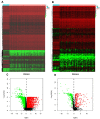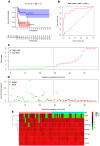Identification of prognostic immune-related genes in rhabdoid tumor of kidney based on TARGET database analysis
- PMID: 33588380
- PMCID: PMC7950296
- DOI: 10.18632/aging.202475
Identification of prognostic immune-related genes in rhabdoid tumor of kidney based on TARGET database analysis
Abstract
Background: Malignant rhabdoid tumor of the kidney (RTK) is a rare and highly aggressive pediatric malignancy. Immune system dysfunction is significantly correlated with tumor initiation and progression.
Methods: We integrated and analyzed the expression profiles of immune-related genes (IRGs) in 65 RTK patients based on the Therapeutically Applicable Research to Generate Effective Treatments (TARGET) database. Prognostic related IRGs in RTK patients were analyzed using univariate and multivariate analysis, based on which a prognostic model with IRGs was constructed. Correlation analysis between the risk score of our model and tumor-infiltrating cell were also investigated.
Results: Twenty two IRGs were significantly associated with the clinical outcomes of RTK patients. Gene ontology (GO) analysis revealed that inflammatory pathways were most frequently implicated in RTK. A prognostic model was constructed using 7 IRGs (MMP9, SERPINA3, FAM19A5, CCR9, PLAUR, IL1R2, PRKCG), which were independent prognostic indices that could differentiate patients based on their survival outcomes. Furthermore, the risk scores from our prognostic model was positively associated with cancer-associated fibroblasts (CAFs).
Conclusions: We screened seven IRGs of clinical significance to distinguish patients with different survival outcomes. This may enhance our understanding of the immune microenvironment of RTK, and could use to design individualized treatments for RTK patients.
Background: Malignant rhabdoid tumor of the kidney (RTK) is a rare and highly aggressive pediatric malignancy. Immune system dysfunction is significantly correlated with tumor initiation and progression.
Methods: We integrated and analyzed the expression profiles of immune-related genes (IRGs) in 65 RTK patients based on the Therapeutically Applicable Research to Generate Effective Treatments (TARGET) database. Prognostic related IRGs in RTK patients were analyzed using univariate and multivariate analysis, based on which a prognostic model with IRGs was constructed. Correlation analysis between the risk score of our model and tumor-infiltrating cell were also investigated.
Results: Twenty two IRGs were significantly associated with the clinical outcomes of RTK patients. Gene ontology (GO) analysis revealed that inflammatory pathways were most frequently implicated in RTK. A prognostic model was constructed using 7 IRGs (MMP9, SERPINA3, FAM19A5, CCR9, PLAUR, IL1R2, PRKCG), which were independent prognostic indices that could differentiate patients based on their survival outcomes. Furthermore, the risk scores from our prognostic model was positively associated with cancer-associated fibroblasts (CAFs).
Conclusions: We screened seven IRGs of clinical significance to distinguish patients with different survival outcomes. This may enhance our understanding of the immune microenvironment of RTK and could use to design individualized treatments for RTK patients.
Keywords: TARGET database; disease prognosis; immune-related genes; malignant rhabdoid tumor of kidney.
Conflict of interest statement
Figures









Similar articles
-
Identification of Potential Biomarkers of Prognosis-Related Long Non-Coding RNA (lncRNA) in Pediatric Rhabdoid Tumor of the Kidney Based on ceRNA Networks.Med Sci Monit. 2020 Dec 17;26:e927725. doi: 10.12659/MSM.927725. Med Sci Monit. 2020. PMID: 33328429 Free PMC article.
-
Identification of Biomarkers to Construct a Competing Endogenous RNA Network and Establishment of a Genomic-Clinicopathologic Nomogram to Predict Survival for Children with Rhabdoid Tumors of the Kidney.Biomed Res Int. 2020 Aug 26;2020:5843874. doi: 10.1155/2020/5843874. eCollection 2020. Biomed Res Int. 2020. PMID: 32908900 Free PMC article.
-
A robust signature associated with patient prognosis and tumor immune microenvironment based on immune-related genes in lung squamous cell carcinoma.Int Immunopharmacol. 2020 Nov;88:106856. doi: 10.1016/j.intimp.2020.106856. Epub 2020 Aug 7. Int Immunopharmacol. 2020. PMID: 32777677
-
Identification of immune-related genes as prognostic factors in bladder cancer.Sci Rep. 2020 Nov 12;10(1):19695. doi: 10.1038/s41598-020-76688-w. Sci Rep. 2020. PMID: 33184436 Free PMC article.
-
Clinical presentation of rhabdoid tumors of the kidney.J Pediatr Hematol Oncol. 2001 Feb;23(2):105-8. doi: 10.1097/00043426-200102000-00007. J Pediatr Hematol Oncol. 2001. PMID: 11216700 Review.
Cited by
-
Neurorescuing effect of Cinacalcet against hypercalcemia-induced nerve injury in chronic kidney disease via TRAF2/cIAP1/KLF2/SERPINA3 signal axis.Cell Biol Toxicol. 2023 Oct;39(5):1-17. doi: 10.1007/s10565-022-09717-1. Epub 2022 May 30. Cell Biol Toxicol. 2023. PMID: 35635602
-
Clinical significance, molecular characterization, and immune microenvironment analysis of coagulation-related genes in clear cell renal cell carcinoma.Cancer Innov. 2024 Jan 7;3(1):e105. doi: 10.1002/cai2.105. eCollection 2024 Feb. Cancer Innov. 2024. PMID: 38948537 Free PMC article.
-
Comprehensive analysis of the importance of PLAUR in the progression and immune microenvironment of renal clear cell carcinoma.PLoS One. 2022 Jun 8;17(6):e0269595. doi: 10.1371/journal.pone.0269595. eCollection 2022. PLoS One. 2022. PMID: 35675366 Free PMC article.
-
Prophylactic cranial irradiation-related lymphopenia affects survival in patients with limited-stage small cell lung cancer.Heliyon. 2023 May 21;9(6):e16483. doi: 10.1016/j.heliyon.2023.e16483. eCollection 2023 Jun. Heliyon. 2023. PMID: 37251477 Free PMC article.
References
-
- Cheng H, Yang S, Cai S, Ma X, Qin H, Zhang W, Fu L, Zeng Q, Wen M, Peng X, Wang H. Clinical and prognostic characteristics of 53 cases of extracranial Malignant rhabdoid tumor in children. A single-institute experience from 2007 to 2017. Oncologist. 2019; 24:e551–58. 10.1634/theoncologist.2018-0416 - DOI - PMC - PubMed
-
- Weeks DA, Beckwith JB, Mierau GW, Luckey DW. Rhabdoid tumor of kidney. A report of 111 cases from the National Wilms’ Tumor Study Pathology Center. Am J Surg Pathol. 1989; 13:439–58. - PubMed
Publication types
MeSH terms
LinkOut - more resources
Full Text Sources
Other Literature Sources
Medical
Miscellaneous

